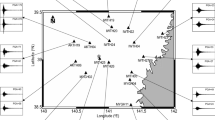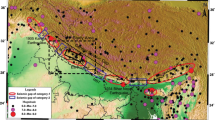Abstract
The Niigata prefecture in Japan was devastated by a large shallow earthquake (M w 6.6, M JMA 6.8) on July 16, 2007. This earthquake has been recorded at 305 stations of Kiban Kyoshin network (KiK-net). Source model of this earthquake has been computed from accelerograms recorded by KiK-net at near-field stations surrounding source of earthquake. Several isolated wave packets were seen in recorded accelerograms at near-field stations surrounding source of this earthquake. Each wave packet in recorded accelerogram represents an isolated patch of envelope of accelerogram released from a rupture plane and is considered to be an independent source of strong motion generation area. Three different isolated wave packets have been identified within the rupture plane of the Niigata earthquake from recorded accelerograms. These isolated wave packets were considered as strong motion generation areas (SMGAs) in the rupture plane. Source parameters of each SMGA were calculated from the source displacement spectra. The approximate locations of SMGAs over the source fault were estimated using spatio-temporal variation of 48 aftershocks recorded by KiK-net and K-NET. Modified semi-empirical method has been used to simulate strong ground motion at various stations. Comparison of the observed and simulated acceleration waveforms is made in terms of root-mean-square error. Comparison of NS and EW component of observed and simulated records at eight stations confirms the suitability of final source model consisting of three SMGAs and efficacy of the modified semi-empirical technique to simulate strong ground motion.















Similar content being viewed by others
References
Aki K, Richards P (2002) Quantitative seismology, 2nd edn. University Science Books, Sausalito
Asano K, Iwata T (2011) Source model for strong ground motion generation in 0.1–10 Hz during the Tohoku earthquake. Earth Planet Space 64(12):111–1123. doi:10.5047/eps.2012.05.003
Boore DM (1983) Stochastic simulation of high frequency ground motion based on seismological models of radiated spectra. Bull Seismol Soc Am 73:1865–1894
Boore DM, Boatwright J (1984) Average body-wave radiation coefficients. Bull Seismol Soc Am 74:615–1621
Boore DM, Bommer J (2005) Processing of strong motion accelerograms: needs, options and consequences. Soil Dyn Earthq Eng 25:93–115
Brune JN (1970) Tectonic stress and spectra of seismic shear waves from earthquakes. J Geophys Res 75:4997–5009
Hartzell SH, Heaton TH (1983) Teleseismic mechanism of the May 02, 1983 Coalinga, California, earthquake from long-period P-waves. In: Bennett JH, Sherburne RW (eds) The 1983 Coalinga, California earthquakes, California Division of Mines and Geology Special Publications, vol 66, pp 241–246
Irikura K (1986) Prediction of strong acceleration motion using empirical Green’s function. In: Proceedings of the 7th Japan earthquake engineering symposium, pp 151–156
Irikura K, Kamae K (1994) Estimation of strong ground motion in broad-frequency band based on a seismic source scaling model and an Empirical Green’s function technique. Ann Geofis XXXVII 6:1721–1743
Irikura K, Kagawa T, Sekiguchi H (1997) Revision of the empirical Green’s function method by Irikura, 1986. Programme and Abstracts. The Seismological Society of Japan, vol 2, p B25
Joshi A (2001) Strong motion modeling of the source of the Chamoli earthquake of March 29, 1999 in the Garhwal Himalaya, India. J Seismol 5:499–518
Joshi A (2004) A simplified technique for simulating wide band strong ground motion for two recent Himalaya earthquakes. Pure appl Geophys 161:1777–1805
Joshi A, Midorikawa S (2004) A simplified method for simulation of strong ground motion using rupture model of the earthquake source. J Seismol 8:467–484
Joshi A, Mohan K (2008) Simulation of accelerograms from simplified deterministic approach for the 23rd October 2004 Niigata-ken Chuetsu earthquake. J Seismol 12:35–51
Joshi A, Patel RC (1997) Modelling of active lineaments for predicting a possible earthquake scenario around Dehradun, Garhwal Himalaya, India. Tectonophysics 283:289–310
Joshi A, Kumar B, Sinvhal A, Sinvhal H (1999) Generation of synthetic accelerograms by modelling of rupture plane. J Earthq Technol 36:43–60
Joshi A, Singh S, Giroti K (2001) The simulation of ground motions using envelope summations. Pure appl Geophys 158:877–901
Joshi A, Pushpa Kumari, Singh S, Sharma ML (2012a) Near-field and far-field simulation of accelerograms of Sikkim earthquake of September 18, 2011 using modified semi-empirical approach. Nat Hazards 64:1029–1054
Joshi A, Pushpa Kumari, Sharma ML, Ghosh AK, Agarwal MK, Ravikiran A (2012b) A strong motion model of the 2004 great Sumatra earthquake: simulation using a modified semi empirical method. J Earthq Tsunami 6:1–29
Joshi A, Sandeep, Kamal (2014) Modeling of strong motion generation areas of the 2011 Tohoku, Japan earthquake using Modified Semi Empirical Technique. Nat Hazard (accepted)
Kamae K, Irikura K (1998) Source model of the 1995 Hyogo-ken Nanbu earthquake and simulation of near-source ground motion. Bull Seismol Soc Am 88:400–412
Kamae K, Kawabe H (2004) Source model composed of asperities for the 2003 Tokachi-oki, Japan, earthquake (M JMA = 8.0) estimated by the empirical Green’s function method. Earth Planet Space 56:323–327
Kameda H and Sugito M (1978) Prediction of strong earthquake motions by evolutionary process model. In: Proceedings of the sixth Japan earthquake engineering symposium, pp 41–48
Kanamori H, Anderson DL (1975) Theoretical basis of some empirical relations in seismology. Bull Seismol Soc Am 65:1073–1095
Kato A, Sakai S, Kurashimo E, Igarashi T, Iidaka T, Hirata N, Iwasaki T, Kanazawa T, Group for the aftershock observations of the 2007 Niigataken Chuetsu-oki Earthquake (2008) Imaging heterogeneous velocity structures and complex aftershock distributions in the source region of the 2007 Niigataken Chuetsu-oki Earthquake by a dense seismic observation. Earth Planets Space 60:1111–1116
Kiyono J (1992) Identification and synthesis of seismic ground motion in structural response analysis. Ph. D. thesis, Department of Civil Engineering Kyoto University
Kumar D, Teotia SS, Khattari KN (1997) The representation of attenuation characteristics of strong ground motion observed in the 1996 Dharamshala and 1991 Uttarkasshi earthquakes by available Empirical relations. Curr Sci 73:543–548
Lay T and Wallace TC (1995) Modern Global Seismology (Academic Press, California, 521 pp)
Midorikawa S (1989) Synthesis of ground acceleration of large earthquakes using acceleration envelope waveform of small earthquake. J Struct Construct Eng 398:23–30
Midorikawa S (1993) Semi empirical estimation of peak ground acceleration from large earthquakes. Tectonophysics 218:287–295
Miyahara M, Sasatani T (2004) Estimation of source process of the 1994 Sanriku Haruka-oki earthquake using empirical Green’s function method. Geophys Bull Hokkaido Univ Sapporo Jpn 67:197–212 (in Japanese with English abstract)
Miyake H, Iwata T, Irikura K (1999) Strong ground motion simulation and source modeling of the Kagoshima-ken Hokuseibu earthquakes of March 26 (M JMA 6.5) and May 13 (M JMA 6.3), 1997, using empirical Green’s function method. Zisin 51:431–442 (in Japanese with English abstract)
Miyake H, Iwata T, Irikura K (2001) Estimation of rupture propagation direction and strong motion generation area from azimuth and distance dependence of source amplitude spectra. Geophys Res Lett 28:2727–2730
Miyake H, Iwata T, Irikura K (2003) Source characterization for broadband ground-motion simulation: kinematic heterogeneous source model and strong motion generation area. Bull Seismol Soc Am 93:2531–2545
National Institute of Earth Sciences and Disaster Prevention (2011) 2011 Off the Pacific Coast of Tohoku earthquake, Strong Ground Motion. http://www.k-net.bosai.go.jp/k-net/topics/TohokuTaiheiyo_20110311/nied_kyoshin2e.pdf. March 13
Nozaki T, Has B (2013) Relationship between geological structure and landslides triggered by the 2007 mid-Niigata offshore earthquake. Earthquake-induced landslides, pp 125–135
Nozu A (2008) Rupture process of the 2007 Chuetsu-oki, Niigata, Japan, earthquake—waveform inversion using empirical Green’s functions. Earth Planets Space 60:1169–1176
Nishiyama T, Fisher GW, Kumon F, Yu KM, Watanabe Y, Motamed A (1992) Metamorphic reactions—kinetics and mass transfer. Sandstone petrology in relation to tectonics. Evaporite and desert environment. In: Proceedings of the 29th International Geological Congress—Part A, Kyoto, Japan, 24 August–3 September 1992. VSP, Utrecht
Pulido N, Ojeda A, Atakan K, Kubo T (2004) Strong ground motion estimation in the Sea of Marmara region (Turkey) based on a scenario earthquake. Tectonophysics 391:357–374
Rathje EM, Abrahamson N, Bray JD (1998) Simplified frequency content estimates of earthquake ground motions. J Geotech Eng 124:150–159
Sandeep, Joshi A, Kamal, Kumar P, Kumar A (2014a) Effect of frequency dependent radiation pattern in simulation of high frequency ground motion of Tohoku earthquake using modified semi empirical method. Nat Hazards 73:1499–1521
Sandeep, Joshi A, Kamal, Kumar P, Kumari P (2014b) Modeling of strong motion generation area of the Uttarkashi earthquake using modified semi-empirical approach. Nat Hazards 73:2041–2066
Shinohara M, Kanazawa T, Yamada T, Nakahigashi K, Sakai S, Hino R, Murai Y, Yamazaki A, Obana K, Ito Y, Iwakiri K, Miura R, Machida Y, Mochizuki K, Uehira K, Tahara M, Kuwano A, Amamiya S, Kodaira S, Takanami T, Kaneda Y, Iwasaki T (2008) Precise aftershock distribution of the 2007 Chuetsu-oki Earthquake obtained by using an ocean bottom seismometer network. Earth Planets Space 60:1121–1126
Si H, Uchiyama F, Matsumoto Y, Saijo Y, Masatsuki T, Kuriyama T (2008) Simulation of strong motion at kashiwazaki during the 2007 Niigataken Chuetsu-oki, Japan, earthquake The 14th world conference on earthquake engineering, October 12–17, 2008, Bei**g
Suzuki W, Iwata T (2007) Source model of the 2005 Miyagi-Oki, Japan, earthquake estimated from broadband strong motions. Earth Planet Space 59:1155–1171
Takiguchi M, Asano K, Iwata T (2011) The comparison of source models of repeating subduction-zone earthquakes estimated using broadband strong motion records–1982 and 2008 Ibaraki-ken-oki M7 earthquakes. J Seismol Soc Jpn 63:223–242 (in Japanese with English abstract)
Toyota H, Onoue A (2008) Characterisation of slope failures during the 2004 Niigata-ken Chuetsu and the 2007 Niigata-ken Chuetsu-oki earthquake The 14th world conference on earthquake engineering, October 12–17, 2008, Bei**g
Wells LD, Coppersmith KJ (1994) New empirical relationships among magnitude, rupture length, rupture width, rupture area and surface displacement. Bull Seismol Soc Am 84:974–1002
Wu C, Koketsu K, Miyake H (2008) Source processes of the 1978 and 2005 Miyagi-oki, Japan, earthquakes: repeated rupture of asperities over successive large earthquakes. J Geophys Res 113:B08316
Acknowledgments
We used the waveform data provided by the KiK-net of the National Research Institute for Earth Science and Disaster Prevention (NIED), Japan. The data obtained from http://www.k-net.bosai.go.jp/k-net/ are thankfully acknowledged. The work presented in this paper is an outcome of the sponsored project from Department of Science and Technology (DST), Government of India with project reference No. GITA/DST/TWN/P-52/2013. Authors sincerely thank Indian Institute of Technology Roorkee and MHRD for supporting the research work presented in this paper.
Author information
Authors and Affiliations
Corresponding author
Rights and permissions
About this article
Cite this article
Sandeep, Joshi, A., Kamal et al. Modeling of strong motion generation areas of the Niigata, Japan, earthquake of 2007 using modified semi-empirical technique. Nat Hazards 77, 933–957 (2015). https://doi.org/10.1007/s11069-015-1636-7
Received:
Accepted:
Published:
Issue Date:
DOI: https://doi.org/10.1007/s11069-015-1636-7




